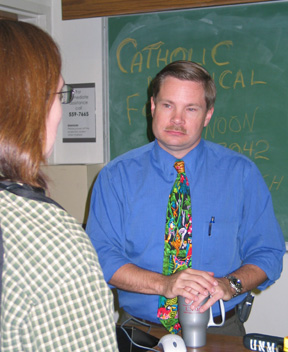 The medical world of Keith Brown, D.O., is similar, whether he’s blazing a trail through the rainforests of Belize or traveling a remote stretch of road in the Nebraska Panhandle.
The medical world of Keith Brown, D.O., is similar, whether he’s blazing a trail through the rainforests of Belize or traveling a remote stretch of road in the Nebraska Panhandle.
“People are surprised at how much wilderness medicine skills and thought processes are applicable to rural Nebraska,” said Dr. Brown, a family medicine physician who recently moved from Gordon to Norfolk, Neb. “Most of what I do in Belize I did in Gordon.”
Dr. Brown travels to Belize four times a year, where he serves as medical director for the Belize Institute for Tropical and Wilderness Medicine and the Belize Cave & Wilderness Rescue Team. Through a series of slides, he recently promoted the wilderness and tropical medicine electives he coordinates in Belize to students in UNMC’s Wilderness Medicine Interest Group and Student Alliance for Global Health.
Dr. Brown is offering students an advanced course in wilderness and tropical medicine in January 2004, and a basic course in June 2004.
“Belize is a very easy place to take students because it is English-speaking, close to the United States, and the rain forest is exquisitely beautiful,” he said. “Many of the students have no experience in wilderness and tropical medicine so watching them grow and expand their horizons is most rewarding.”
At the same time, it is a difficult place to travel, Dr. Brown said. Only three of its major highways are fully paved and prices are high for the tiny, Central American country on the Caribbean Sea. “Still, people are people everywhere,” he said. “Individuals in Belize deal with diabetes, arthritis and hypertension, just as we do.”
An assistant professor at UNMC, Dr. Brown led the medical response in Belize for Hurricane Iris; is the author of the Belize Health Care Special Report, an inspection report of the entire Belize medical system; and has more than 25 years experience in wilderness medicine, search and rescue, EMS, law enforcement, firefighting and military special operations. He is in charge of developing the EMS/village health worker curriculum for Belize, which is bordered by Mexico and Guatemala.
The Kansas native, who spent six years in Gordon before moving to Norfolk this summer, has participated in medical missions since the mid-1980s. “Rural medicine and wilderness medicine have a great deal to do with each other,” he said. “The skill sets, tools and attitude of how you apply rural medicine are similar to what you do in wilderness medicine.”
To varying degrees, both face challenges of isolation, including physical distance, limited resources and communication and long transport times. “You deal with what you have, which may be a very small first aid kit or nothing at all,” he said.
As a result, improvising is critical, he said. The Belize trip teaches students “unique techniques not taught in medical school,” he said, such as diagnosing fractures without an X-ray machine by using brains, hands and a tuning fork (or, if a tuning fork isn’t available, two quarters).
“Our goal is to save lives, save limbs and control pain,” he said, while getting patients to definitive care. Carrying patients through rugged terrain can be daunting, he said, and can require rescue teams to change handlers every 100 yards.
His slides also showed health-care professionals working by kerosene lamp or flashlight, practicing water and cave rescues and visiting Mayan ruins. One slide featured a Spanish cedar, whose trunk was wider than four adults with their hands outstretched.
“Students (who travel to Belize) discover things about themselves that they would not discover otherwise,” he said. “It’s a wonderful opportunity to face challenges and learn what you’re capable of doing.”
To learn more about the Belize courses, visit http://www.unmc.edu/isp (click on the link for Wilderness & Tropical Medicine).